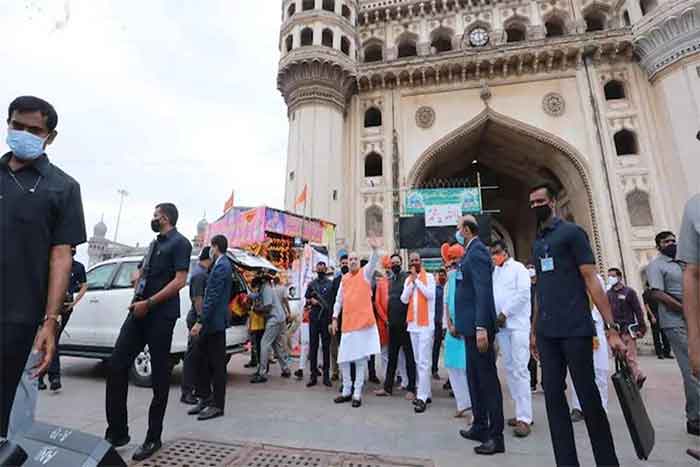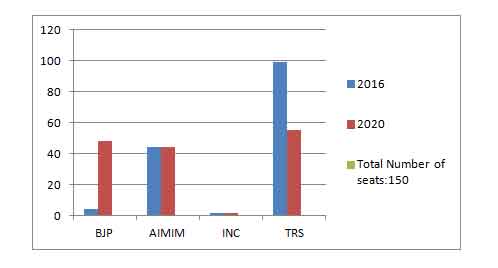Written by Md Rahat Hasan & Mohd Shahwaiz

The election of Greater Hyderabad Municipal Corporation (GHMC), 2020 perhaps characterized the most happening civic body election in the history of India. The reason behind gaining attention of media and political pundits was the extreme level of politics of polarization played by both Bhartiya Janta Party (BJP) and AIMIM. The GHMC consists of Hyderabad – the capital of Telangana – and Secundarabad. It is one of the largest Municipal Corporations in India that comprises of 6.9 million populations and area of 625 km2. As per the census 2011, the GHMC has 64.93% Hindus, 30.13% Muslims, 2.75% Christians, 0.29% Jains, 0.25% Sikhs, and 0.04% Budhdhist population. Due to the presence of large percentage of Muslim population in the GHMC, it became natural for both BJP and AIMIM to play the politics of communal polarization. As a result of divisive politics, the AIMIM succeeded in securing their previously owned seats and BJP got a gain in the number of seats that rose from only 4 seats in 2016 to 48 seats in 2020. Interestingly, in the battle of communal polarization (polarization and anti-polarization), the regional sentiments and developmental slogans of Telangana Rashtra Samiti (TRS) were overshadowed that resulted in the great loss of TRS in terms of decline of seats from 99 to 55 in GHMC election 2020. Another take out of the election is that the Indian National Congress (INC) contested all 150 seats but won only 2 seats.

Figure: Comparison of Political Parties’ performance in GHMC
Unfortunately, the slack attitude of INC as a secular party was not able to enhance its seats but also failed to provide an alternative of TRS which eventually helped BJP to hold it footprints not only in Hyderabad but also in South Indian politics.
Divisive Politics
The ‘divisive politics’ remained the most visible feature in the GHMC Election. The BJP and AIMIM, claimed to be patron of Hindus and Muslim respectively, made efforts to communalize the voters instead of raising local developmental issues. The BJP employed its firebrand faces, like UP CM Yogi Adityanath and Tejasvi Surya, and the BJP president, J.P Nadda, and the Union Home Minister, Amit Shah who made massive communal speeches in order to mobilize the Hindu voters. For example, Uttar Pradesh Chief Minister and BJP leader Yogi Adityanath while addressing a public meeting at Lal Darwaza in Shah Ali Banda area of the Old City of Hyderabad called upon people to change the city’s name from Hyderabad to ‘Bhagyanagar’. He said that only if Hyderabad becomes ‘Bhagyanagar’ then the city could be on the road to ‘vikas’ (development). The UP CM further said that “people of Hyderabad often ask me if Hyderabad can be renamed Bhagyanagar. I tell them why not. Then, they ask me how. I tell them that it will be done the same way we changed the name of Faizabad to Ayodhya and Allahabad to Prayagraj in Uttar Pradesh”. In addition, BJP state president, Bandi Sanjay Kumar, said that “after a BJP candidate becomes Mayor, we will do a surgical strike on old city and chase out Rohingyas and Pakistanis”. He also alleged TRS and AIMIM for trying to win the municipal polls with the illegal votes of Rohingyas, Pakistanis and Afghanistanis. Apart from surgical strike and Bhagyanagar, the other slogans of BJP campaign revolved around naming “Owaisi as Jinnah” and “beef and pork biryani”.
In response of BJP divisive politics, AIMIM party chief, Asaduddin Owaisi, appealed to the people of old city of Hyderabad to make ‘democratic strike’ by voting AIMIM in reaction of BJP’s remark of surgical strike. He also hit back on Yogi Aditynath’s remark of changing name of Hyderabad by saying that the Uttar Pradesh chief minister’s generation may end but the city will continue to be called as Hyderabad”. He appealed to people that “if you want Hyderabad not to be renamed then vote for Majlis”.
Fading of Regional Sentiments and Congress as ‘slacker’
The election result of GHMC has outshined image of Telangana Chief Minister K. Chandrasekhar Rao’s as the unquestionable leader of his state. As a result, the number of TRS’s seats fell to 55 from 99 in the 2016 election. The election result also indicated that the multi-party system in Telangana has become bi-party system – TRS and BJP apart from AIMIM influence in Muslim dominated areas. The dominance of TDP and Congress has largely minimized and their votes have transferred to BJP. In the election, the TDP has drawn a blank and the Congress, which was considered as the principal opposition, ended up with two seats only. As a result, the election was a direct fight between TRS and BJP in which BJP tried and succeeded in mobilizing Hindu votes.
Moreover, the TRS is facing a greater level of anti-incumbency than it ever has in the past six years and KCR’s repeated regional sentiment had lesser influence over the people. However, TRS primary poll plank was developmental issues but it did not seem to have reverberated with the voters. The TRS’s campaign centred around KCR and his family. His son, K.T. Rama Rao (KTR), who also IT Minister was made in-charge of the party’s GHMC election campaign. KCR’s daughter Kavitha also campaigned in the election. This gave the BJP an opportunity to criticise the TRS for its apparent ‘dynasty rule’. Amit Shah also targeted TRS and AIMIM for their unofficial alliance.
Conclusion
Although The GHMC election 2020 was a civic body election but it pulled the attention of political analysts, national and local media. The major take out of this election was the momentum rise of BJP in GHMC. Interestingly, BJP took this local body election very seriously and saw it as an opportunity to enhance its footholds in Telangana in particular and South Indian politics in general. The seriousness of BJP reflected in the constant visits of prominent leaders of the party. Another interesting outcome was the role of communal politics in mobilizing voters against the politics of regional sentiments, development and secularism.
Md Rahat Hasan is Assistant Professor at the Department of Political Science, Aligarh Muslim University (AMU), UP. He can be reached at [email protected].
Mohd Shahwaiz is a Research Scholar at the Department of Political Science, Aligarh Muslim University, Aligarh. He can be contacted at [email protected]
SIGN UP FOR COUNTERCURRENTS DAILY NEWSLETTER










































